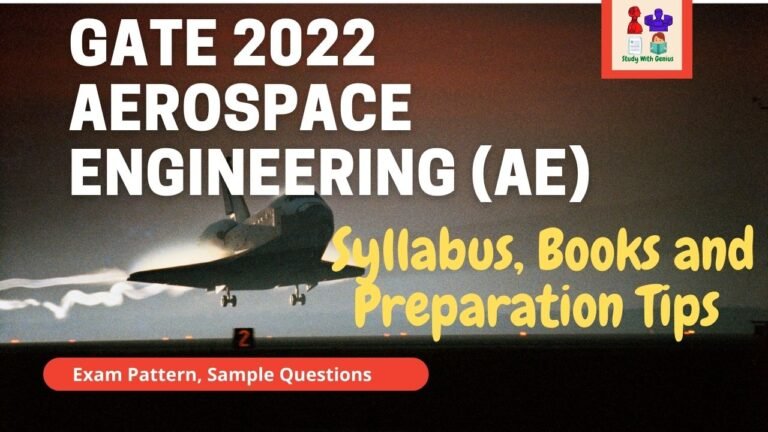GATE 2022 Aerospace Engineering (AE) Syllabus, Preparation Tips and Books

The Aerospace Engineering Syllabus for GATE 2022 is broken into six categories. The themes have also been separated into two groups: Core Topics and Special Topics. The appropriate sections of the GATE 2021 question paper will include 90% of their questions on Core Topics and 10% on Special Topics.
- 85 percent of the questions are from the subject-specific curriculum and engineering mathematics, while the other 15% are from the general aptitude component. GATE 2021 Exam Schedule
- The Aerospace engineering paper requires applicants to complete 65 questions in three hours.
The major branch of engineering involved with the development of aircraft and spacecraft is aerospace engineering. Candidates who are taking the GATE Aerospace Engineering test should review the updated syllabus for better preparation.
GATE 2021 qualifiers will be able to enrol in M.Tech programmes at IITs, NITs, and other institutions. Candidates can read the article to learn more about the new curriculum, exam pattern, preparation suggestions, and literature in order to prepare for the exam.
GATE 2022 Aerospace Engineering Syllabus
Section1: Engineering Mathematics
Core Topics:
Linear Algebra: Vector algebra, Matrix algebra, systems of linear equations, rank of a matrix, eigenvalues and eigenvectors.
Calculus: Functions of single variable, limits, continuity and differentiability, mean value theorem, chain rule, partial derivatives, maxima and minima, gradient, divergence and curl, directional derivatives. Integration, Line, surface and volume integrals. Theorems of Stokes, Gauss and Green.
Differential Equations: First order linear and nonlinear differential equations, higher order linear ODEs with constant coefficients. Partial differential equations and separation of variables methods.
Fourier Series, Laplace Transforms, Numerical methods for linear and nonlinear algebraic equations, Numerical integration and differentiation. Complex analysis. Probability and statistics.
Section 2: Flight Mechanics
Core Topics:
Basics:
- Atmosphere: Properties, standard atmosphere. Classification of aircraft. Airplane (fixed wing aircraft) configuration and various parts. Pressure altitude; equivalent, calibrated, indicated air speeds; Primary flight instruments: Altimeter, ASI, VSI, Turn-bank indicator. Angle of attack, sideslip; Roll, pitch & yaw controls. Aerodynamic forces and moments.
Airplane performance:
- Drag polar; takeoff and landing; steady climb & descent; absolute and service
ceiling; range and endurance, load factor, turning flight, V-n diagram. Winds: head, tail & cross winds.
Static stability:
- Stability & control derivatives; longitudinal stick fixed & free stability; horizontal tail
position and size; directional stability, vertical tail position and size; lateral stability. Wing dihedral,
sweep & position; hinge moments, stick forces.
Dynamic stability: Euler angles; Equations of motion; Decoupling of longitudinal and lateral-directional dynamics; longitudinal modes; lateral-directional modes.
Section 3: Space Dynamics
Core Topics:
Central force motion, determination of trajectory and orbital period in simple cases. Kepler’s laws; escape velocity
Orbit transfer, in-plane and out-of-plane.
Section 4: Aerodynamics
Core Topics:
Basic Fluid Mechanics:
- Conservation laws: Mass, momentum and energy (Integral and differential form); Dimensional analysis and dynamic similarity; Potential flow theory: sources, sinks, doublets, line vortex and their superposition. Elementary ideas of viscous flows including boundary layers.
Airfoils and wings:
- Airfoil nomenclature; Aerodynamic coefficients: lift, drag and moment; Kutta Condition theorem; Thin airfoil theory, Kutta condition, starting vortex; Finite wing theory: Induced
drag, Prandtl lifting line theory; Critical and drag divergence Mach number.
Compressible Flows:
- Basic concepts of compressibility, One-dimensional compressible flows, Isentropic
flows, Fanno flow, Rayleigh flow; Normal and oblique shocks, Prandtl-Meyer flow; Flow through
nozzles and diffusers.
Wind Tunnel Testing: Measurement and visualization techniques. Shock – boundary layer interaction.
Section 5: Structures
Core Topics:
Strength of Materials:
- Stress and strain: Three-dimensional transformations, Mohr’s circle, principal
stresses, Three-dimensional Hooke’s law, Plane stress and strain.
Failure theories:
- Maximum stress, Tresca and von Mises. Strain energy. Castigliano’s principles. Statically determinate and indeterminate trusses and beams. Elastic flexural buckling of columns.
Flight vehicle structures:
- Characteristics of aircraft structures and materials. Torsion, bending and shear of thin-walled sections. Loads on aircraft.
Structural Dynamics:
- Free and forced vibrations of undamped and damped SDOF systems. Free vibrations
of undamped 2-DOF systems.
Vibration of beams, Theory of elasticity, Equilibrium and compatibility equations, Airy’s stress function.
Section 6: Propulsion
Core Topics:
Basics:
- Thermodynamics, boundary layers, heat transfer, combustion and thermochemistry.
Aerothermodynamics of aircraft engines: Thrust, efficiency, range. Brayton cycle.
Aerothermodynamics of aircraft engines:
- Thrust, efficiency, range. Brayton cycle.
Engine performance:
- ramjet, turbojet, turbofan, turboprop and turboshaft engines. Afterburners.
Turbomachinery:
- Axial compressors: Angular momentum, work and compression, characteristic performance of a
single axial compressor stage, efficiency of the compressor and degree of reaction, multi-staging.
Centrifugal compressor:
- Stage dynamics, inducer, impeller and diffuser. Axial turbines: Stage performance.
Rockets:
- Thrust equation and specific impulse, rocket performance. Multi-staging. Chemical rockets. Performance of solid and liquid propellant rockets.
Aerothermodynamics of non-rotating propulsion components such as intakes, combustor and nozzle. Turbine blade cooling. Compressor-turbine matching, Surge and stall.
GATE 2022 Exam Pattern of Aerospace Engineering
- Mode of Examination: Online
- Duration of Exam: 3 hours
- Types of Questions: MCQs and NAT
- Sections: 3 sections – General Aptitude, Mathematics and Subject-based
- Total Questions: 65 questions
| Section | Distribution of Marks | Total Marks | Types of questions |
|---|---|---|---|
| General Aptitude | 5 questions of 1 mark each 5 questions of 2 marks each | 15 marks | MCQs |
| Engineering Mathematics Subject Syllabus (AE) | 25 questions of 1 mark each 30 questions of 2 marks each | 85 marks | MCQs and NATs |
Marking scheme:
- Total Marks: 100 marks
- Negative Marking: For MCQs only
| Type of question | Negative marking for wrong answer |
|---|---|
| MCQs | ⅓ for 1 mark questions ⅔ for 2 marks questions |
| NATs | No negative marking |
GATE 2022 Aerospace Engineering Section Wise Books
Reference books are one of the most important tools for preparing for any exam. They provide almost all of the information needed to begin studying the subject. Candidates can refer to the section-by-section important book list below:
Engineering Mathematics Important Books
| Books | Author/Publisher |
|---|---|
| GATE Engineering Mathematics for All Streams | Abhinav Goel and Suraj Singh, Arihant Publication |
| Higher Engineering Mathematics | B.S.Grewal, Khanna Publishers |
| GATE Engineering Mathematics | Abhinav Goel, Arihant Publications |
| GATE 2020: Engineering Mathematics | ME Team, Made Easy Publications |
Flight Mechanics Important Books
| Books | Author/Publisher |
|---|---|
| Introduction to Flight | John D Anderson, Tata McGraw - Hill Education |
| Flight Mechanics Modeling and Analysis | Jitendra R. Raol, Jatinder Singh, Crc Press |
| Mechanics of Flight | R. H. Barnard, Pearson |
| Mechanics of Flight | C. Kermode, R. H. Barnard, Pearson Higher Education |
Aerodynamics Important Books
| Books | Author/Publisher |
|---|---|
| Fundamentals of Aerodynamics | John D Anderson, Tata McGraw - Hill Education |
| Aerodynamics for Engineering Students | E. L. Houghton, P. W. Carpenter, Butterworth Heinemann |
| Fundamentals of Aerodynamics | John D. Anderson, Tata McGraw - Hill Education(2010) |
| Aerodynamics for Engineers | John J. Bertin, Pearson |
Structure Important Books
| Books | Author/Publisher |
|---|---|
| Theory of Structures | Ramamrutham, Dhanpat Rai Publishing Company |
| Structural Analysis | S.S. Bhavikatti, Vikas Publishing House |
| Matrix Methods of Structural Analysis | S.S. Bhavikatti, I K International Publishing House Pvt. Ltd |
| Theory of Structures SMTS | B.C. Punmia, Ashok Kumar Jain, Laxmi Publications |
Propulsion Important Books
| Books | Author/Publisher |
|---|---|
| Rocket Propulsion Elements | George P. Sutton, Wiley India Pvt Ltd |
| Aircraft Propulsion | Mayur R. Anvekar, Prentice-Hall of India Pvt.Ltd |
| Marine Propellers and Propulsion | Carlton |
| Submarine Propulsion: Muscle Power to Nuclear | Sekhar Basu, Kamlesh N Vyas, Frontier India |
Preparation Tips for GATE 2021 Aerospace Engineering
1. Solving Practice Papers
- Solve practise papers on a daily basis to obtain a better understanding of the exam pattern, question types, difficulty level, and so on.
- Examine your weak spots.
- If you are unable to answer the questions, do not become concerned.
2. Try to Complete whole Syllabus
- Do not save any topics at the last minute. Try to finish your syllabus at least two weeks before the exam.
- You must begin your improvements when you have completed your curriculum.
- Make sure you go over your syllabus several times to ensure you don’t forget anything.
3. Regular Practice
- Daily question practise will assist you in slowing down your ageing process.
- Candidates must also keep in mind that while their speed improves, their accuracy must improve as well.
- Make an effort to complete more and more mock tests.
| Time Allotment | Activities to Do |
|---|---|
| 5:00 AM to 8:00 AM | Revision of Topics |
| 8:00 AM to 10:00 AM | Take a Break |
| 10:00 AM to 1:00 PM | Pick up a Major Topic |
| 1:00 PM to 5:00 PM | Take a Break |
| 6:00 PM to 9:00 PM | Pick up next/incomplete topic |
| 10:00 PM | Revise again |







